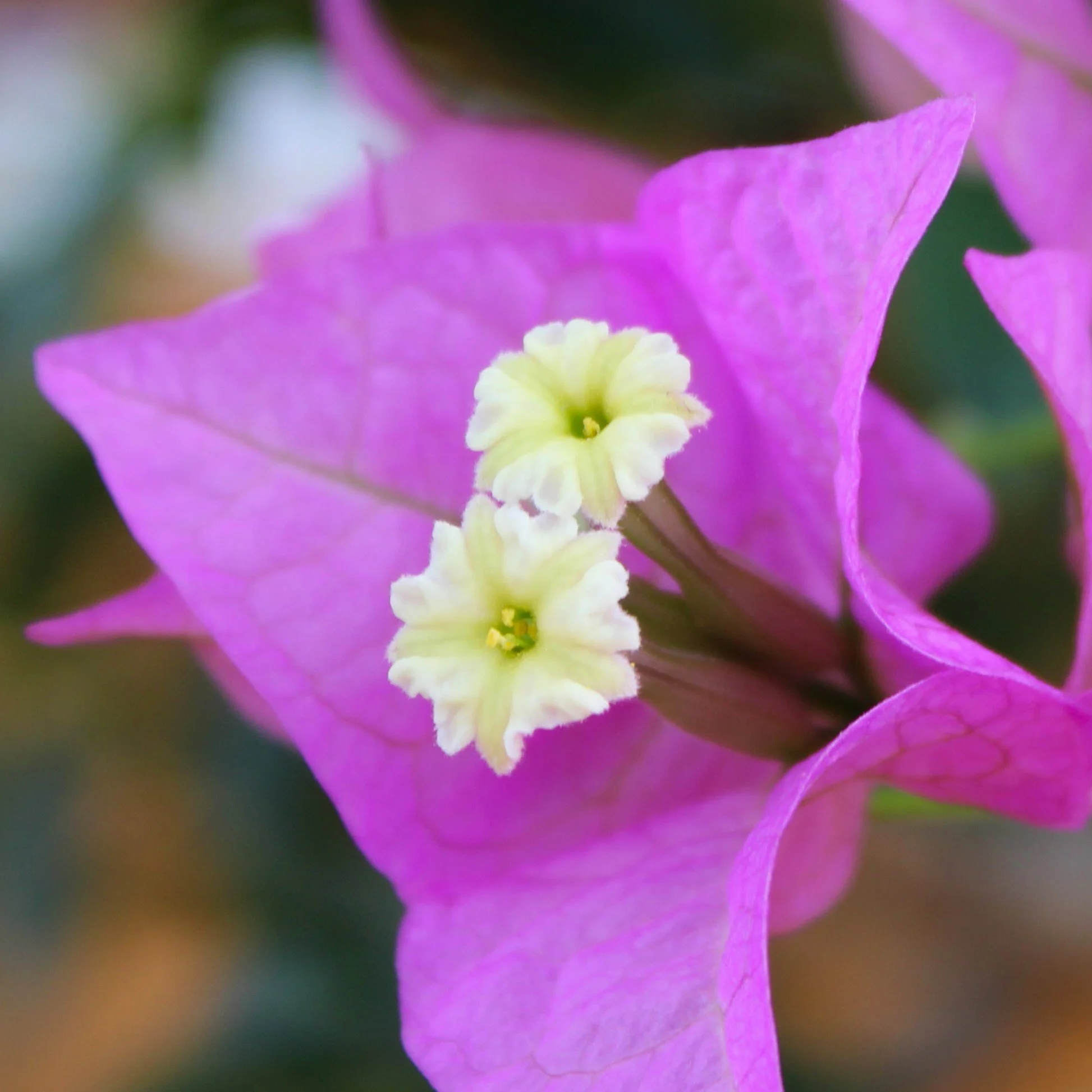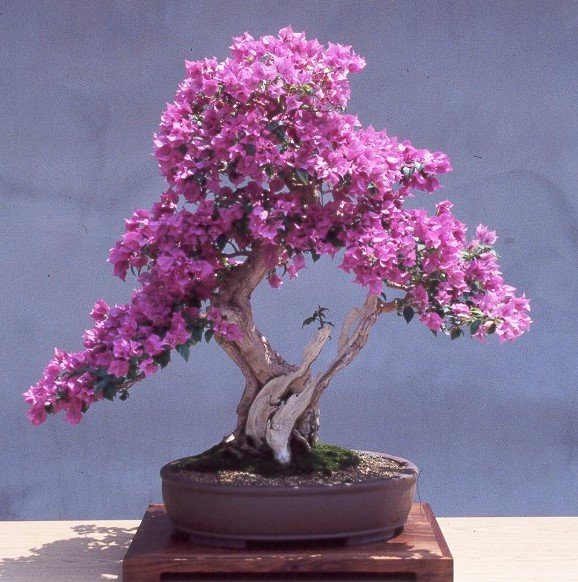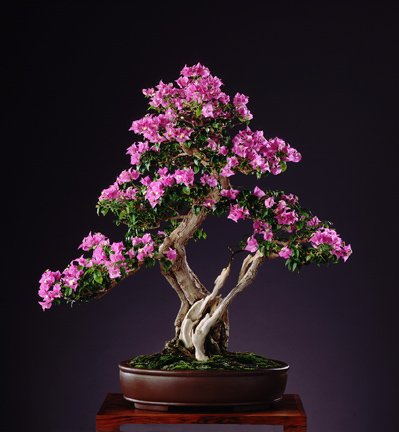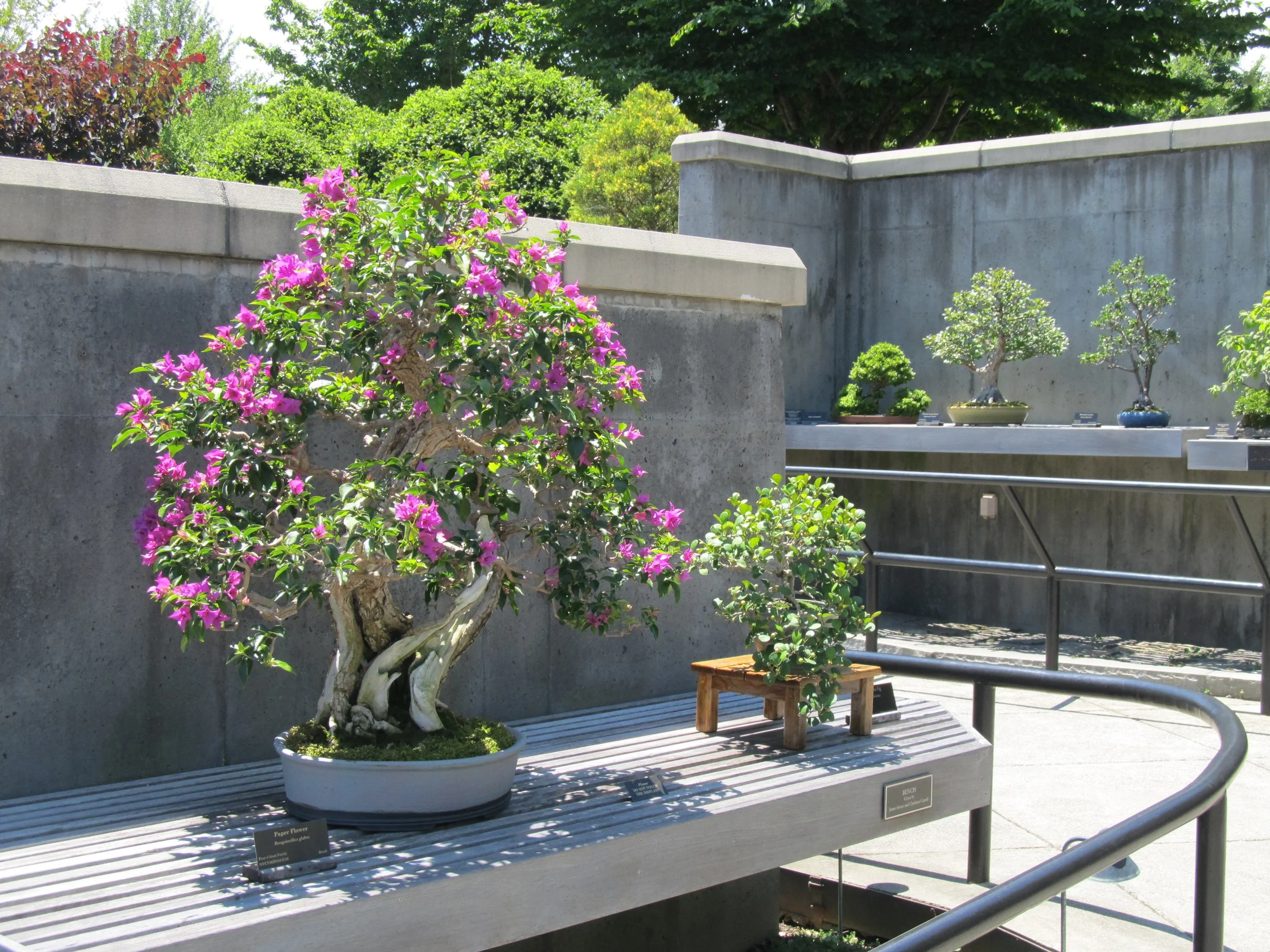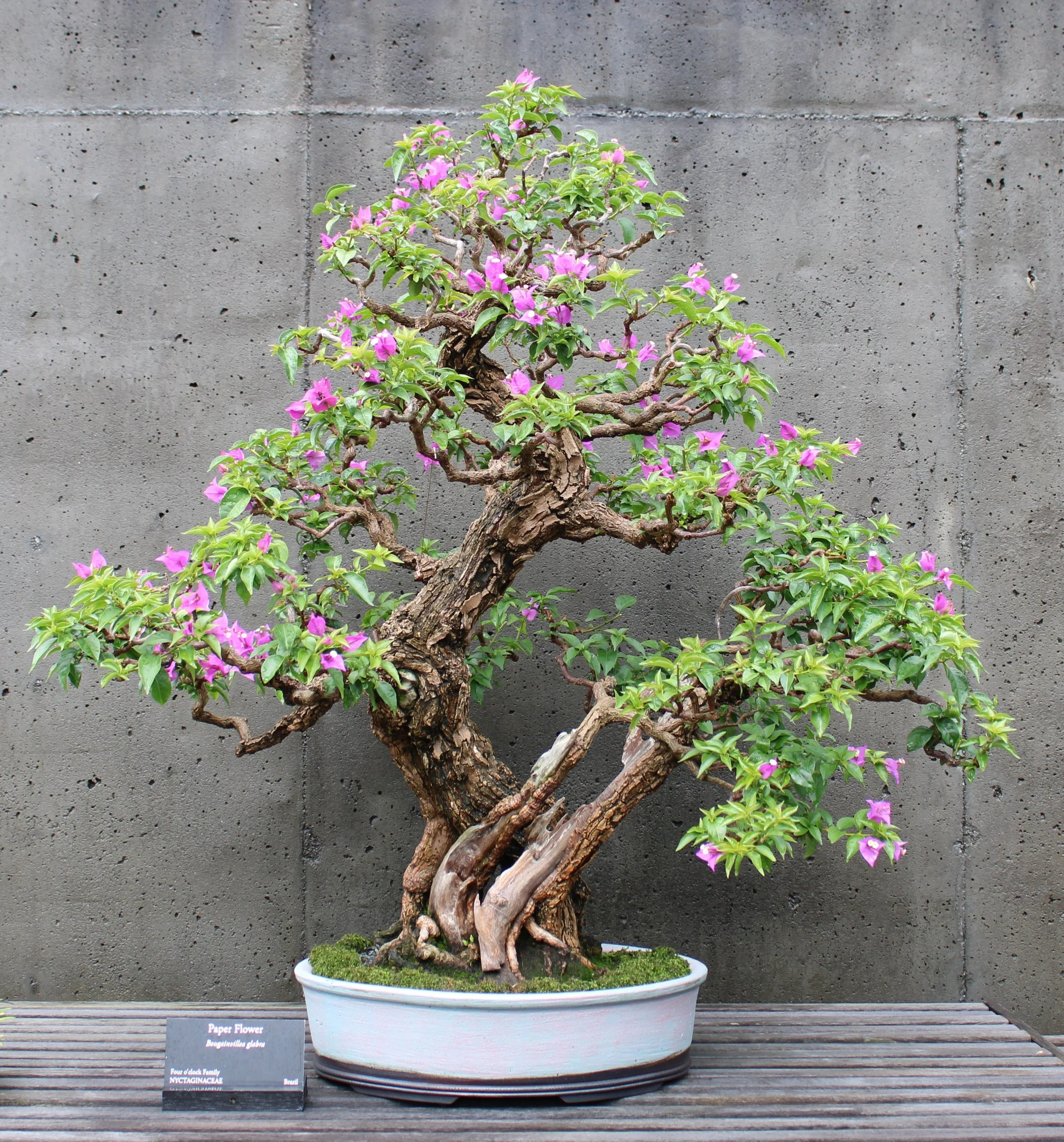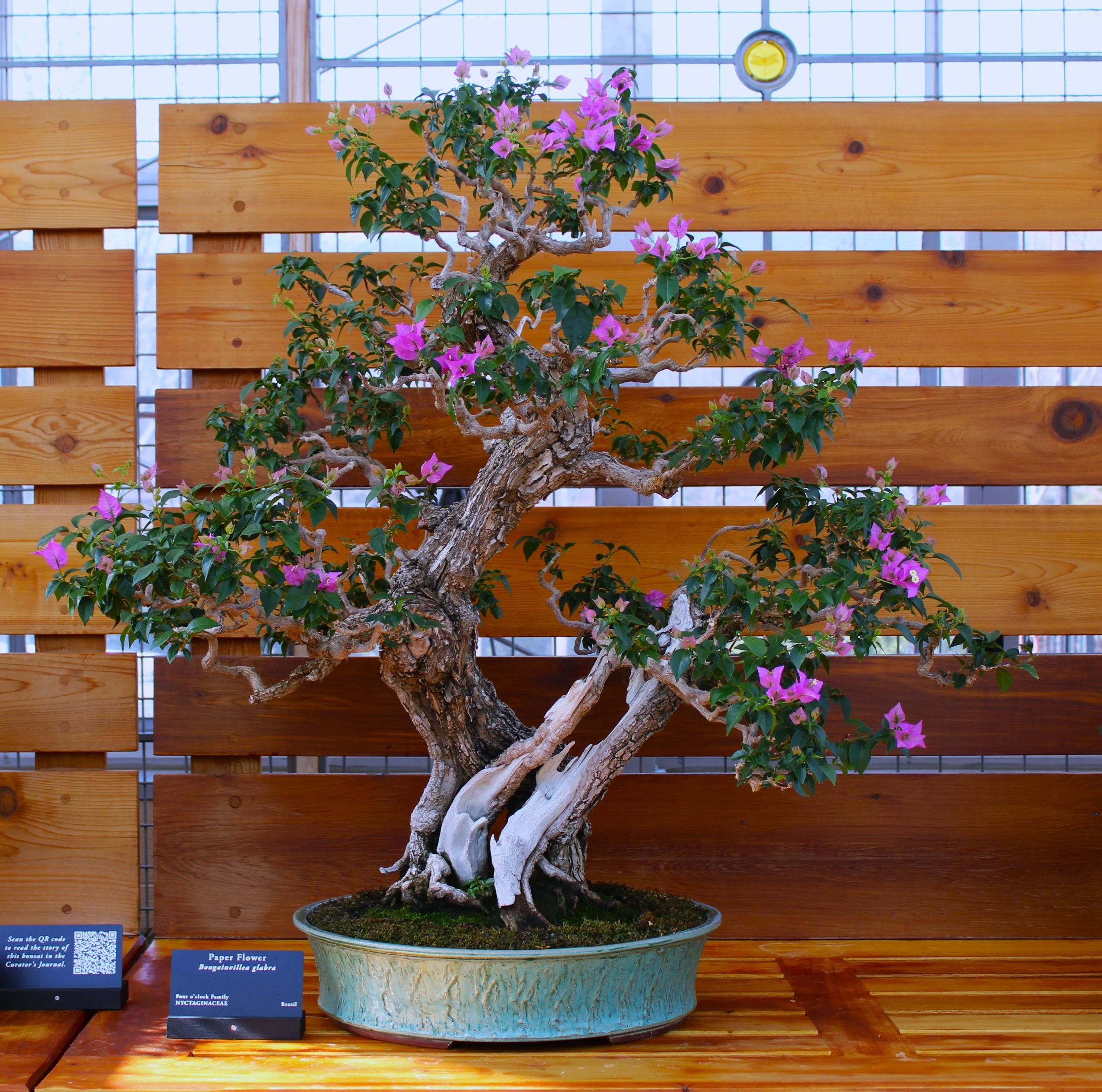Bougainvillea
The common name for Bougainvillea (Bougainvillea glabra) is Paper Flower, and that's how we have it on the label that accompanies the tree on display. I never think of our specimen by that name, though. The first I ever heard of this tropical vine was in 1992 when a large, rangey plant in the Staples bonsai donation was identified to me as a bougainvillea, and that's just how that plant has stayed in my mind ever since. Some plants are like that -- the botanical name can double as a common name.
In talking to visitors from warm, sunny places like Florida and California I've come to know bougainvillea as a South American native that has been introduced and naturalized in the southernmost United States. In some places where it has taken up residency it is viewed as an invasive pest, albeit a beautiful one. It is a thorny, sprawling plant with a weedy growth habit that flowers profusely as it overtakes everything it its path. As with our native dogwood, what people think of as flowers on the bougainvillea are actually large, showy bracts. The bracts on the Arboretum bougainvillea are a pinkish-magenta in color. The actual flowers are found nestled down in the center of a cluster of three bracts. They are pretty little trumpets, creamy white in color, but very small. The bracts provide the obvious beauty on a flowering bougainvillea. They are produced in abundance and each cluster lasts for weeks. (Click on either image below for larger view:)
The bougainvillea in our collection could hardly have been called a bonsai when we received it. The plant appeared to have had no training whatsoever. The wild thing looked like it had been collected from some landscape, cut back and stuffed into a bonsai pot just as it was. There were two trunks, each as thick as an adult's forearm, with many gangling branches randomly jutting out to form an incoherent tangle. Here is a photograph showing just how raw this plant material was when we got it:
Not long after the above image was made, on one of Don Torppa's consultation visits with me at the Arboretum, he and I were looking over the tropical portion of the donated collection. We came to the bougainvillea and he considered it a moment. "Don't even bother with this one," he finally said. "What do you mean?" I asked. "Send this one to the compost pile," he said. "It's no good?" I asked. "Oh, something could be made of it,” he said. “But it would be a project. You have so many other plants to deal with, your time would be better spent working on trees that aren't so far away from being ready to show."
It was reasonable advice but I did not take it. Once Don in his role as hired consultant designated the bougainvillea as being excess plant material — not worth the trouble — it became valuable to me. I was not trying to prove anything or setting out on a mission to save it, but once the bougainvillea was deemed unworthy that meant nothing I might do to it would mess it up. I could try to make a good bonsai out of the wild bougainvillea just for practice, and if it didn't work out the plant could still go to the compost pile. I'd get experience, if nothing else.
Starting out in the design effort, I thought settling the issue of the two competing trunks was the first order of business. These two trunks were not joined at the base but were pressed so tightly together prying them apart would have been too invasive. I could not separate them and I would not choose to cut one of them out altogether. Having decided both trunks would remain, it then became necessary to make them more noticeably unequal. When a composition has two primary elements it is usually desirable that one of them be dominant and the other subordinate. Both trunks would stay but one would have to be reduced:
Which trunk should be reduced? The trunk in front was more stout but not appealingly shaped. The trunk in back was more naturally upright and had some movement to it. I decided to use the back trunk as the main line of the tree, then reduced the trunk in front by cutting it back aggressively and making deadwood out of much of what remained. It was unknown to me how well bougainvillea would hold up as deadwood, but I was winging it with a sense of nothing to lose. I'd get practice carving, if nothing else.
At the start of 1995 the bougainvillea looked like this:
The above image was another of those I took with me when I went to study with Mr. Yoshimura. When I showed him the photo I told him the bonsai was one I had shaped myself. He suggested that the primary trunk could stand independently, and the secondary trunk with the deadwood could be eliminated altogether. Then Mr. Yoshimura commented that he thought the pot the bougainvillea was in was right because, "it goes along with the Chinese feeling of the bonsai." It is not necessarily a compliment when a Japanese bonsai teacher tells you such a thing. I took no offense from it, though, because I had seen pictures and live examples of Chinese penjing by then and thought some of it looked pretty good.
I chose to keep the secondary trunk where it was, contrary to Mr. Yoshimura's advice. There was something he could not see in the photograph — the base of the primary trunk was split in two. It gave the appearance of standing on stilts, but the base of the secondary trunk hid that from view.
This photo from later in 1995 documents that the bougainvillea had been repotted, its position changed to be more upright, and heavy aluminum wire was being used to train the branching:
In less than five years after the above image was made, the bougainvillea shaped up enough to put on a respectable show:
The flowers routinely produced by this specimen were so impressive that in 2000 the Arboretum hired a professional photographer to do a studio portrait:
Photo by Terry Davis
The bougainvillea was displayed on one of the large granite tables when the Bonsai Exhibition Garden opened in October of 2005:
Photo by David Keller
On display again four years later in 2009:
In the above image take note of the lower right side of the canopy. When the trunk leaning to the right side was reduced and partially made into a deadwood element, the living branches growing off of it were expressed to the right to act as the lowest branching on that side of the tree. At the point in time when the above image was made the foliage mass created by those branches was as flat as a pancake. Managing the branching of this specimen has been a constant demand, due, I think, to the great vigor with which bougainvillea grows. All sorts of different techniques have been employed over the years in order to develop branches and organize them into a more aesthetically pleasing configuration. The next set of photos shows the method used at the end of 2009 to address the two-dimensional foliage mass. The first pair of images show the before and after appearance of the branching in that lower right area of the crown:
The following images show the full system used to make the branch adjustments. A bamboo rod was attached to the upper portion of the crown that extended down into the area of branching coming off the secondary trunk. A guy wire pulling off the rod was then deployed to make a powerful downward branch adjustment. A second guy wire helped in the effort, that one pulling down to where a screw had been introduced to the base of the tree to act as an anchor. This combination allowed for the training to take place over several years to ensure success, without ever having to worry about wire biting in. The bougainvillea was not displayed during the time it was trussed up so:
Other work was done on the tree at this time, but by 2017 it was ready to be shown again. That year the Arboretum premiered a new winter bonsai display in the Baker Exhibit Center greenhouse, and the bougainvillea decided it would be a good time to shine:
The revamped bougainvillea had also received a new container, made by Jack Hoover of Eagleville Bonsai Pottery in Rhode Island. The pot was chosen because the color of the glaze paired nicely with the color of the tree's bracts. Here the bougainvillea is seen on display in the garden in 2018:
In 2019 the bougainvillea was given a detailed pruning which left it mostly devoid of foliage. This created an opportunity to clearly see the structure of the tree after twenty-four years of development. A series of four images was made to allow for an in-the-round view, rotating clockwise from upper left (click on any image for full view):
In the third image above, showing the opposite side of the tree from what is usually presented, the split in the base of the primary tree can be seen. Looking at this view of it, it is possible to visualize what the bougainvillea might have become if I had followed Mr. Yoshimura's advice and removed entirely the secondary trunk. It still would have made a good tree, but different!
The bougainvillea just coming into flower while on display in the garden in 2021:
The bougainvillea just coming into flower while on display in the Baker greenhouse in 2023:
The new container in which the bougainvillea now resides was made by Robert Wallace of Wallace Woods Pottery in Columbus, North Carolina. This is a vigorous, sizable specimen and it outgrew the previous container in five years time.
Often I look at this bonsai and imagine how I would go about it differently if given the exact same material I started with in 1993. For certain, the outcome would not be the same. All my ideas about bonsai have evolved since this bougainvillea was set on its course three decades ago, but there is no good use in changing what has been done. This specimen is big, colorful and popular as it is.


